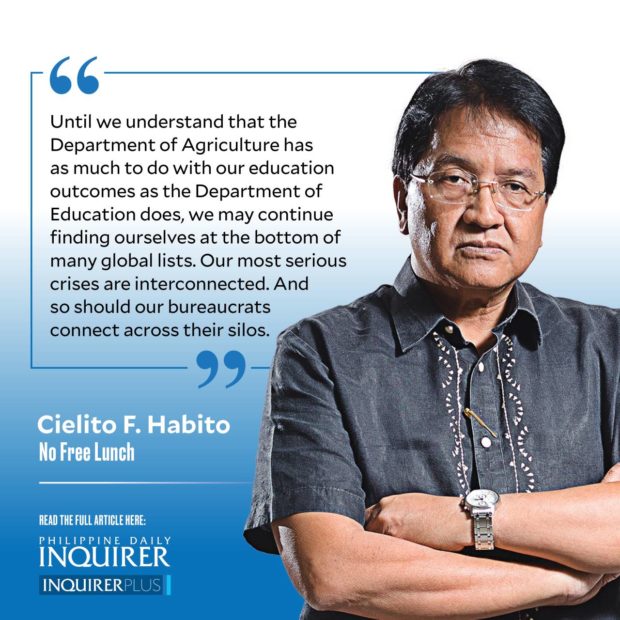Our interconnected crises
 The human costs of COVID-19 and how we managed it heightened grave threats to the nation’s future that had been looming even before the pandemic. We have a ticking time bomb in our midst that needs to be defused fast with decisive reform and wide collective action.
The human costs of COVID-19 and how we managed it heightened grave threats to the nation’s future that had been looming even before the pandemic. We have a ticking time bomb in our midst that needs to be defused fast with decisive reform and wide collective action.
Many are already aware of our stunting problem, wherein one in every three Filipino children 5 years old and below is stunted due to chronic malnutrition, as reported by the Food and Nutrition Research Institute (FNRI). A child is stunted when his/her height is lower than the median (average) height for his/her age by two standard deviations or more. In 2015, incidence among 5-year-olds and younger was 33.4 percent, and had inched down to 28.8 percent in 2019. But the pandemic more than doubled the incidence of forced hunger, based on the Social Weather Stations’ regular survey—and it is quite likely that early childhood stunting has also escalated in turn.
I have written before about why our high incidence of stunting, which is among the highest in our part of the world, is a silent crisis in our midst. FNRI describes it as a “silent pandemic.” It’s not the height that is the main problem here; it’s the underdevelopment of the child’s brain that is. It’s a fact that 90 percent of a human’s brain development happens by age 5. Brain scans of healthy and stunted children indeed show that the latter have much less brain tissue or white matter, which is essential to memory, cognitive ability, and overall mental capacity. Thus, a chronically malnourished child who is stunted at age 5 will no longer be able to achieve his/her full physical and mental potential, and is irreversibly damaged for life. Studies have consistently shown that early childhood stunting has adverse long-term effects on individuals and entire societies, including poor cognition and educational performance, low productivity as adults, and consequently, lower earnings or wages.
Our other silent crisis is the alarmingly abysmal average performance of our elementary and high school students in international comparisons. It is now well-known that the Philippines ranks at the bottom in reading comprehension and second to the bottom in science and mathematics among 79 participating countries in the 2018 Program for International Student Assessment. Recently, the World Bank released the latest country assessments on learning poverty, which measures the percentage of children who cannot read and understand the simple text by age 10. The Philippines rated a dismally high 90.9 percent, far exceeding Indonesia’s 52.8, Malaysia’s 42, Thailand’s 23.4, Vietnam’s 18.1, and Singapore’s 2.8 percent. And even as our education was already in crisis before COVID-19, the pandemic set us back further with over two years of remote learning that put children from poor families and far-flung areas with no connectivity at an even greater disadvantage.
The two crises are closely intertwined. Our serious education crisis is not just about classrooms and teachers but also traces more fundamentally to the silent pandemic of stunting and malnutrition that has afflicted our children for decades. That helps explain why we ranked lowest (with an average of 86) among all 10 Asean countries in average IQ in a cross-country assessment in the early 2000s. Even the best teachers can only do so much for a pupil whose learning has been compromised by early childhood stunting or distracted by hunger pangs in the classroom. School feeding programs are important, but making sure pregnant and lactating mothers are able to eat well is even more critical and urgent. And our overly protective (rather than nurturing and enabling) agricultural policies, which pushed food prices higher than they need to be, ultimately led to the poor’s food insecurity, malnutrition, and poor education outcomes, hence perpetuating their poverty.
Until we understand that the Department of Agriculture has as much to do with our education outcomes as the Department of Education does, we may continue finding ourselves at the bottom of many global lists.
Our most serious crises are interconnected. And so should our bureaucrats connect across their silos.
cielito.habito@gmail.com
For more news about the novel coronavirus click here.
What you need to know about Coronavirus.
For more information on COVID-19, call the DOH Hotline: (02) 86517800 local 1149/1150.
The Inquirer Foundation supports our healthcare frontliners and is still accepting cash donations to be deposited at Banco de Oro (BDO) current account #007960018860 or donate through PayMaya using this link.




















